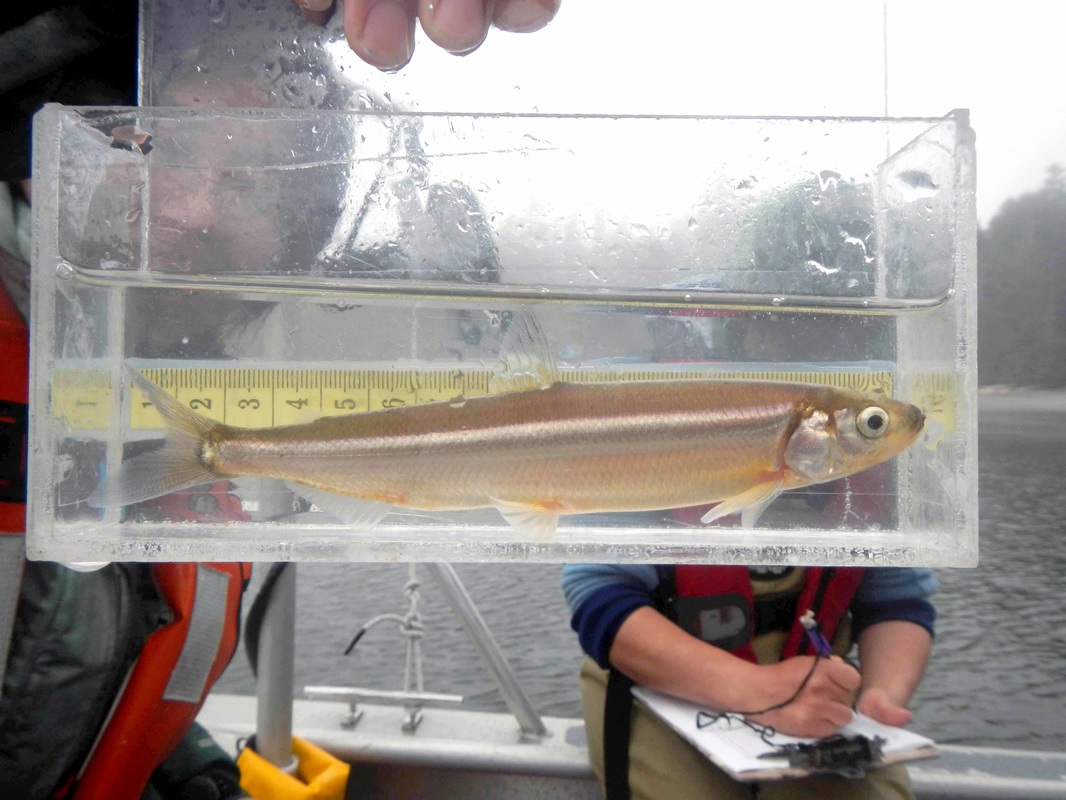Surf smelt • Hypomesus pretiosus
Identification
The surf smelt is differentiated from other small silvery and streamlined forage fish by a relatively small mouth and eyes, a small and rounded adipose fin, pelvic fins that attach behind the dorsal fin, and a short, incomplete lateral line. While its overall colouring is silver, its back is light brownish to olive green, and it has a reflective line running along both sides. During spawning season males take on a golden tone. This fish reaches 30.5 cm long.
Habitat & Range
This schooling marine fish remains in nearshore waters and estuaries, particularly juveniles. Surf smelt move close to sandy and gravelly shorelines to spawn in shallow waters. Surf smelt are found along coastlines from the Alaskan Peninsula and Gulf of Alaska to southern California.
Human Uses
While this species is still commercially and recreationally fished in some areas along its range (see the Fisheries and Oceans Canada surf smelt page for fishery information), population declines have occurred. Both commercial and recreational fisheries are mostly conducted from shore, using beach seines, dip nets, and hook and line jig gear.
Intriguing Info
Shoreline modifications such as sea walls can destroy or degrade the sand and gravel sediment shorelines that surf smelt require for spawning habitat.
iNaturalist
https://www.inaturalist.org/taxa/117566-Hypomesus-pretiosus
The surf smelt is differentiated from other small silvery and streamlined forage fish by a relatively small mouth and eyes, a small and rounded adipose fin, pelvic fins that attach behind the dorsal fin, and a short, incomplete lateral line. While its overall colouring is silver, its back is light brownish to olive green, and it has a reflective line running along both sides. During spawning season males take on a golden tone. This fish reaches 30.5 cm long.
Habitat & Range
This schooling marine fish remains in nearshore waters and estuaries, particularly juveniles. Surf smelt move close to sandy and gravelly shorelines to spawn in shallow waters. Surf smelt are found along coastlines from the Alaskan Peninsula and Gulf of Alaska to southern California.
Human Uses
While this species is still commercially and recreationally fished in some areas along its range (see the Fisheries and Oceans Canada surf smelt page for fishery information), population declines have occurred. Both commercial and recreational fisheries are mostly conducted from shore, using beach seines, dip nets, and hook and line jig gear.
Intriguing Info
Shoreline modifications such as sea walls can destroy or degrade the sand and gravel sediment shorelines that surf smelt require for spawning habitat.
iNaturalist
https://www.inaturalist.org/taxa/117566-Hypomesus-pretiosus
References
Fisheries and Oceans Canada. (2016). Surf smelt Hypomesus pretiosus. Accessed 31/08/2017.
Lamb, A. and Edgell, P. Coastal Fishes of the Pacific Northwest. Revised. (2010). Madeira Park, BC: Harbour Publishing. Pp. 51-52.
Luna, S.M and Reyes, R.B. Hypomesus pretiosus (Girard 1854) Surf smelt. FishBase. Accessed 31/08/2017.
Washington Department of Fish and Wildlife. (2010). Washington State Surf Smelt Fact Sheet. Accessed 31/08/2017.
Authors and editors of page
Kelly Fretwell (2017)
Fisheries and Oceans Canada. (2016). Surf smelt Hypomesus pretiosus. Accessed 31/08/2017.
Lamb, A. and Edgell, P. Coastal Fishes of the Pacific Northwest. Revised. (2010). Madeira Park, BC: Harbour Publishing. Pp. 51-52.
Luna, S.M and Reyes, R.B. Hypomesus pretiosus (Girard 1854) Surf smelt. FishBase. Accessed 31/08/2017.
Washington Department of Fish and Wildlife. (2010). Washington State Surf Smelt Fact Sheet. Accessed 31/08/2017.
Authors and editors of page
Kelly Fretwell (2017)





